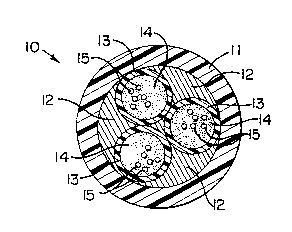Some of the information on this Web page has been provided by external sources. The Government of Canada is not responsible for the accuracy, reliability or currency of the information supplied by external sources. Users wishing to rely upon this information should consult directly with the source of the information. Content provided by external sources is not subject to official languages, privacy and accessibility requirements.
Any discrepancies in the text and image of the Claims and Abstract are due to differing posting times. Text of the Claims and Abstract are posted:
| (12) Patent: | (11) CA 2093593 |
|---|---|
| (54) English Title: | CABLE WITH LIGHT WAVEGUIDE TUBES IN A MATRIX |
| (54) French Title: | CABLE SOUS TUBES GUIDE D'ONDE LUMINEUSE DISPOSES EN MATRICE |
| Status: | Expired and beyond the Period of Reversal |
| (51) International Patent Classification (IPC): |
|
|---|---|
| (72) Inventors : |
|
| (73) Owners : |
|
| (71) Applicants : |
|
| (74) Agent: | GOWLING WLG (CANADA) LLP |
| (74) Associate agent: | |
| (45) Issued: | 1996-12-03 |
| (22) Filed Date: | 1993-04-07 |
| (41) Open to Public Inspection: | 1993-10-14 |
| Examination requested: | 1993-04-07 |
| Availability of licence: | N/A |
| Dedicated to the Public: | N/A |
| (25) Language of filing: | English |
| Patent Cooperation Treaty (PCT): | No |
|---|
| (30) Application Priority Data: | ||||||
|---|---|---|---|---|---|---|
|
A simplified loose tube fiber optic cable, and a method for making the cable,
is disclosed. A plurality of transmission units, each including a plurality of light
waveguides and filling compound in a buffer tube, are provided. The transmission
units are stranded together with a plurality of tensile yarns coated with a hardenable
material. After the hardenable material is cured, an outer tube is extruded over the
buffer tubes and coated tensile yarns.
Note: Claims are shown in the official language in which they were submitted.
Note: Descriptions are shown in the official language in which they were submitted.

2024-08-01:As part of the Next Generation Patents (NGP) transition, the Canadian Patents Database (CPD) now contains a more detailed Event History, which replicates the Event Log of our new back-office solution.
Please note that "Inactive:" events refers to events no longer in use in our new back-office solution.
For a clearer understanding of the status of the application/patent presented on this page, the site Disclaimer , as well as the definitions for Patent , Event History , Maintenance Fee and Payment History should be consulted.
| Description | Date |
|---|---|
| Inactive: IPC deactivated | 2011-07-27 |
| Inactive: First IPC derived | 2010-02-01 |
| Inactive: IPC from MCD | 2010-02-01 |
| Inactive: First IPC derived | 2006-03-11 |
| Time Limit for Reversal Expired | 2005-04-07 |
| Letter Sent | 2004-04-07 |
| Grant by Issuance | 1996-12-03 |
| Application Published (Open to Public Inspection) | 1993-10-14 |
| All Requirements for Examination Determined Compliant | 1993-04-07 |
| Request for Examination Requirements Determined Compliant | 1993-04-07 |
There is no abandonment history.
| Fee Type | Anniversary Year | Due Date | Paid Date |
|---|---|---|---|
| MF (patent, 5th anniv.) - standard | 1998-04-07 | 1998-03-18 | |
| MF (patent, 6th anniv.) - standard | 1999-04-07 | 1999-03-24 | |
| MF (patent, 7th anniv.) - standard | 2000-04-07 | 2000-03-20 | |
| MF (patent, 8th anniv.) - standard | 2001-04-09 | 2001-03-21 | |
| MF (patent, 9th anniv.) - standard | 2002-04-08 | 2002-03-20 | |
| MF (patent, 10th anniv.) - standard | 2003-04-07 | 2003-03-20 |
Note: Records showing the ownership history in alphabetical order.
| Current Owners on Record |
|---|
| SIECOR CORPORATION |
| Past Owners on Record |
|---|
| RICHARD S. WAGMAN |